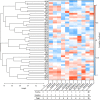Hippocampal transcriptome analysis following maternal separation implicates altered RNA processing in a mouse model of fetal alcohol spectrum disorder
- PMID: 32416732
- PMCID: PMC7231420
- DOI: 10.1186/s11689-020-09316-3
Hippocampal transcriptome analysis following maternal separation implicates altered RNA processing in a mouse model of fetal alcohol spectrum disorder
Abstract
Background: Fetal alcohol spectrum disorders (FASD) are common, seen in 1-5% of the population in the USA and Canada. Children diagnosed with FASD are not likely to remain with their biological parents, facing early maternal separation and foster placements throughout childhood.
Methods: We model FASD in mice via prenatal alcohol exposure and further induce early life stress through maternal separation. We use RNA-seq followed by clustering of expression profiles through weighted gene co-expression network analysis (WGCNA) to analyze transcriptomic changes that result from the treatments. We use reverse transcription qPCR to validate these changes in the mouse hippocampus.
Results: We report an association between adult hippocampal gene expression and prenatal ethanol exposure followed by postnatal separation stress that is related to behavioral changes. Expression profile clustering using WGCNA identifies a set of transcripts, module 19, associated with anxiety-like behavior (r = 0.79, p = 0.002) as well as treatment group (r = 0.68, p = 0.015). Genes in this module are overrepresented by genes involved in transcriptional regulation and other pathways related to neurodevelopment. Interestingly, one member of this module, Polr2a, polymerase (RNA) II (DNA directed) polypeptide A, is downregulated by the combination of prenatal ethanol and postnatal stress in an RNA-Seq experiment and qPCR validation (q = 2e-12, p = 0.004, respectively).
Conclusions: Together, transcriptional control in the hippocampus is implicated as a potential underlying mechanism leading to anxiety-like behavior via environmental insults. Further research is required to elucidate the mechanism involved and use this insight towards early diagnosis and amelioration strategies involving children born with FASD.
Keywords: Fetal alcohol spectrum disorder; Gene expression; Hippocampus; Maternal separation; Prenatal alcohol; WGCNA.
Conflict of interest statement
Authors have no financial or competing interests to declare.
Figures



References
Publication types
MeSH terms
Substances
LinkOut - more resources
Full Text Sources
Medical
Molecular Biology Databases

